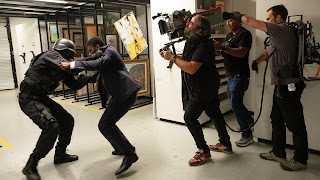Chico's Film: Critical Reflection
Question 1: How do your products represent social groups or issues?
Answer: Our product represents the social groups of families and how they often treat those who they view as below them. Now Chico, the titular dog, is not a human, but it’s clear that everyone can relate to the feelings of humiliation that he feels in the beginning of the story. He is made to dress up in outfits that could be considered humiliating, for example, the onesie with a banana pattern. While Chico’s owner finds these costumes adorable, Chico is clearly less than amused. Additionally, his feelings often go unheard by his family. He cannot communicate how he feels because he is a dog, but there is a certain relatability in not being able to express how you truly feel. The audience is able to sense his feelings through context and the text presented in the film, but Chico’s owner is clearly unaware. Similar situations can arise when especially young children are treated like objects in their families. These children are made to dress up in silly outfits, (sometimes)placed on social media without their true consent or knowledge, and their feelings are rarely expressed. This can be because they simply can’t speak yet or don’t understand the implications of being placed on the internet for thousands or even millions of people to see. Such experiences rarely lead to the kind of violence we see Chico take part in at the end of the film, but the feelings of rage and hurt that Chico feels can still be present when those children get older and realize what was done to them. Generally, our film focuses on the humiliation that families can bring to those around them, without realizing.
Question 2: How do the elements of your production work together to create a sense of 'branding'?
Answer: The elements of our production were, a short film of 5 minutes, a postcard advertising our movie, a website, and three social media accounts. One element that we used to create a sense of branding is color. Color psychology is a very important aspect of advertising, branding, and marketing. While a good design should be able to be recognized without color, a memorable design is one with good color language, which can be achieved through the use of color psychology. Essentially, certain colors can imply certain meanings to the mind. For example, blue can mean tranquility in a positive sense, or sadness in a negative sense. The colors we used for our film were red and black. Red can symbolize power, warmth, and love in a positive sense, but since this is a horror film and the title has the term “revenge’ in it, the implication of the colors becomes violence, blood, and anger. These implications help brand our movie as scary and slightly gory. The black surrounding the red takes on the same negative connotation, implying darkness and death.
Additionally, we added a personal touch to our website to create a sense of branding throughout the entire package. It makes sense that our website will be the first thing that a person will see, likely before they view our film. Therefore, I wanted to be sure that the website, while still thematically appropriate, did have some elements of me and Naliah thrown in, mostly through our creator bios. This gives anyone who views our website an insight into our lives and our journey in the creation of this film. This has the potential to attract an additional audience and allow our film to be viewed by many more people, with us associated with the overall sense and brand of 'Chico's Revenge.'
Question 3: How do your products engage with the audience?
Our products engage with the audience in a couple of main ways: through creating emotion and creating interest.
Firstly, emotion is created by the film itself and the more personal aspects of our website. Fear is the primary emotion that I aimed to create in this film, but additionally humor needed to present as well, just to stay within the conventions of the chosen genre. Fear is created through a variety of ways: firstly, there’s the slow build up to Chico’s first kill. While the climax of our story may be considered late in the film, I personally found that it made sense to have a slower build up to Chico’s violence. The audience knows that it’s likely for Chico to kill, so the main question is not if, but when it will happen. Knowing that something horrible is going to happen and not knowing when can be one of the most horrifying feelings, so it makes sense to incorporate anything that can bring that feeling into this film. Additionally, some humor is created. Chico, being a chihuahua, is seen generally as either as a silly, harmless dog or an evil one that truly cannot do much, which makes Chico an ironic and unexpected antagonist. This subversion of expectation is the basis of comedy, which is why it is included. Our personal appearance is created through our bios on the website.
Interest was created through our socials and our postcards. By sharing our stories and advertising through our postcard, we managed to attract an audience to our film. As the designer of the aforementioned postcard, I made sure to make the postcard simplistic but intriguing. The front design includes a version of our movie poster with the slogan “A good dog gone bad...” acting as a film tagline. This will get an audience interested because they want to know what the dog did to go from good to bad, and how this impacts the world around him.
Question 4: How did your research inform your products and the way they use or challenge conventions?
The research we did spanned both genres of comedy and horror and they had a great influence on how we challenged certain conventions and used others. Firstly, the fact that our film is a genre bender by being a horror comedy is a huge defiance of conventions. Films are typically one genre (maybe two that are closely related), which makes certain filmmaking elements and conventions easy to recognize. When we did our research, we at first were going to settle for a horror film, but then the possibility of a genre bender came up and we felt that it would make for a more interesting and enjoyable film. By taking what makes up the typical horror film and putting a comedic twist on certain elements (i.e., a scary antagonist, typically clueless characters), it created a film that embodied what we truly wanted to achieve. However, we did keep some conventions the same. One prominent example is the usage of sound to enhance horror. In this film, I made sure to include powerful sound effects to emphasize moments of horror, like when the dog trainer stumbles upon the first corpse she sees. There’s also the use of soundtracks, which are used minimally and also for emphasis during the final chase scene. These are fairly common conventions in horror films that I believed would work well to contribute to the film.




Comments
Post a Comment